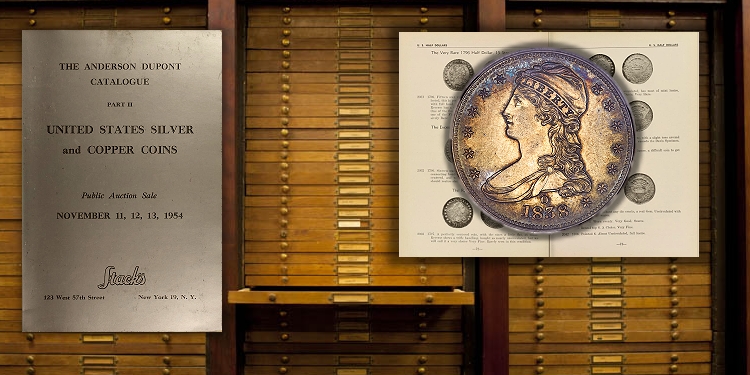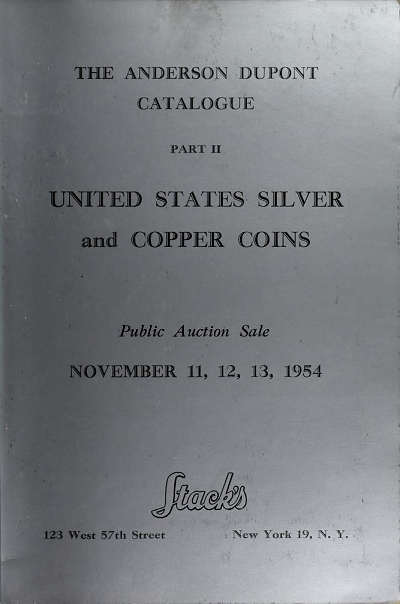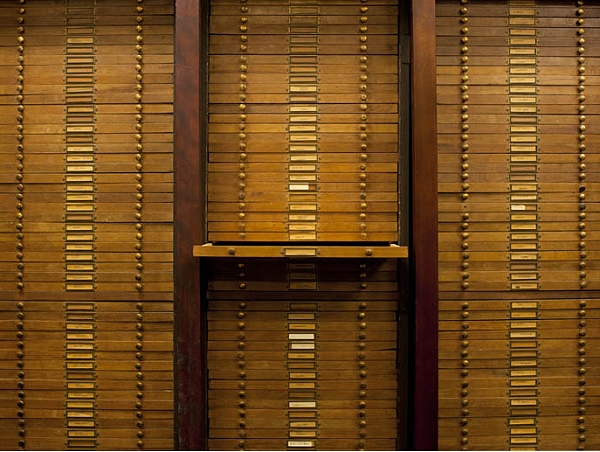
By Harvey Stack – Co-Founder, Stack’s Bowers Galleries ……
Links to Part 1 | Part 2 | Part 3 | Part 4 | Part 5
1954 Continued
After the initial sale in March was sold, we offered a second section to the Davis-Graves Collection – of which the specialized collection of foreign gold coins numbered some 645 lots of scarce and rare world gold coins. Following that section, we offered duplicates and some unusual American coins, highlighted by an 1879 Stella and some pioneer gold, including the rare 1849 Moffat $16.00 ingot. Various other U.S. Gold was offered as well, including a run of $10 gold eagles from 1795 to 1804, with both varieties of l798.
With the sale of the Davis-Graves Collection successfully concluded, the firm went “full speed ahead” in starting to catalog the Anderson-Dupont Coin Collections.
The ANDERSON-DUPONT COIN COLLECTION of United States Copper, Nickel and Silver coins was one of the most comprehensive collections of U.S. silver and copper coins to be offered on the auction market for years. The U.S. gold in the collection was not planned to be in the sale (this will be explained later).
The collection was one of extreme size, and an attempt by the collector to have an extensive collection from the dates our Mint started to strike coins all the way through to the mid-1930s. It had varieties and rare dates, in nice circulated condition, Mint State and Proof, which was evidence of the coins found by the collector during the decades he formed the collection.
Sale of the Anderson-Dupont Coin Collection
To give you an idea of the extent of the collection, one of the feature series was U.S. LARGE CENTS. It had over 1,000 dates and varieties from 1793 to 1857. It contained many high-quality and rare examples, and because of the scope and extent of this very unusual collection the one and only Dr. William Sheldon offered to catalog it (we accepted, of course). This collection alone, besides all the work Dr. Sheldon did in his first book, U.S. Large Cents 1793-1814 (which became the new standard reference book in 1949), provided much information as to rarity, quality, and survival.
 To me, working directly with Dr. Sheldon and and his helper Doug Smith was as if I went to school to learn more about grading cents, identifying varieties and having a greater appreciation for the Large Copper Series. The value of the Anderson-Dupont Collection was that it contained coins that had been acquired from collections sold as far back as 50 years or more before we acquired it… collections that were therefore not available to be cataloged until 1954.
To me, working directly with Dr. Sheldon and and his helper Doug Smith was as if I went to school to learn more about grading cents, identifying varieties and having a greater appreciation for the Large Copper Series. The value of the Anderson-Dupont Collection was that it contained coins that had been acquired from collections sold as far back as 50 years or more before we acquired it… collections that were therefore not available to be cataloged until 1954.
To give you an idea as to the scope of the collection there were 19 examples of the 1793 Chain and Wreath cents; 75 dates and varieties from 1794 (really a study group), and a total of 344 dates and varieties from 1795 to 1814, followed by 784 later dates from 1816 through 1857. Many were in the condition census class; others were among the best known of certain varieties. A large number of the cents were in Mint State or Proof, and working with all of them was a great learning experience.
The Large Cent portion of the Anderson-Dupont Coin Collection was sold in September 1954. Dr. Sheldon did a fine job of cataloging the coins, and our photographer Sam Andre did a great job in capturing the details of the coins (we had a large group illustrated on full-page photo plates within the catalog). Once Dr. Sheldon revealed in detail what was forthcoming, the huge community of “Large Penny” collectors and followers in the Northeast gathered together as excitement for the sale developed rapidly. We needed extra people to show lots and time to discuss some of the new information that appeared in our auction catalog. The catalog became a new reference book.
Collectors started to talk about what they wanted to acquire and even made “deals” as to which they would bid on and what they would “layoff on” and not bid. Dr. Sheldon had a special group of collectors who also wanted to make “deals with each other” and we noted that Sheldon, as the leader of the group, helped decide who would bid on what.
Of course, he let them know which coins he wanted to acquire, and they seemed to want to follow the “leader”.
The evening the Large Cent Sale was offered, the auction room filled up quickly with some 300 seated collectors and standing room only for the balance attending. It was noted by me, who was to be a “spotter” for bids for my uncle the auctioneer, that an unfamiliar yet attractive lady had come into the room and seated herself next to the side door of the auction room. Before the sale started, my secretary came running over to me, saying that the young lady was to be bidding with the initials D.N. (we used initials at the time, not bidder numbers) and that the stranger had left a substantial deposit. Wow, a new bidder, unknown to anyone, could break up the unknown deals between the collectors and there would be great competition.

When the sale started, Dr. Sheldon sat on the side aisle with some dozen or more known collectors near him. When the bidding started, Sheldon seemed to orchestrate it all, and his side of the room bid to a certain level then stopped for the moment. It seemed that at a certain level only one bidder from the Sheldon group was bidding.
Suddenly, from the other side of the room, “D.N” bid, and continued bidding until the Sheldon side stopped. She won the lot. She did the same thing on a number of the 1793 cents. As we got to the extensive group of 1794s, she selected certain scarce or choice examples and topped the other bidders.
“D.N.” topped off the “Combine”.
By the time we got to continue, I heard Sheldon whisper to those around him: “Guys you all are on your own. Forget the deals we made, and bid ON YOUR OWN!!” The “mystery lady” defeated the “combine” and the sale – both sessions were record-breaking. It helped establish new values for the “Big Cent”. We, who were there, watched history unfold.
The second part of the Anderson-Dupont Coin Collection sale took place in November. The value, rarity, and great opportunity to get some “great coins” from an “Old Time Collection” that was “fresh to the market” were here once again, and it garnered the same public interest as the Davis-Graves collection sold earlier that Spring.
The silver and other copper and nickel coins of America was quite complete and had numerous high-quality rarities seldom seen together in one sale.
The second part of the collection included Half Cents, Small Cents, Three Cent Nickel and Silver, Half Dimes, Dimes, Quarters, Half Dollars, and silver dollars – from the first years of issue to the mid-1930s when made.
It started with HALF CENTS from 1793, and included great choice examples of 1796 pole to cap, and 1796 No pole, and followed by numerous Mint State examples, and almost all the Proofs struck, Originals and Restrikes, and a few patterns.
Following those were full offerings of Small Cents, Two Cents, Three Cent nickel and silver coins – mostly Mint State or Proofs. Half Dimes followed starting with a Half Disme, and again high-quality examples in Proof and Mint State. The Dime series followed with the early issues, choice examples from 1796 on again with many choice examples from all the mints that issued from l796 to the 1930s well represented.
The Quarter series started with 1796 and included the choice 1823 and 1827 to lead the almost complete series in outstanding grade.
In the Half Dollar Series, interest in varieties included from 1794, 1795 3 leaf, both varieties of 1796, l797 and the very rare 1838-O. It was virtually complete through to the 1930s – with the majority in Mint State and Proof.
The Silver Dollars was also noteworthy for varieties from 1794 on, and many of the scarce and rare dates represented. Many Mint State and Proof examples highlighted this series.
The work in the office was intense. Everyone did their job, gave up nights and weekends to get the work out while still running the retail and mail-order business, attending shows, and traveling to visit collectors. I was 26 at the time and wondered how my father and uncle kept the same pace as I did. But it was the excitement of getting the work out and offering two great collections at public auction. Now we did forego the opportunity of going to Egypt, but we were rewarded with the great successes of that year.
Gold for Mr. Lilly
You might be asking: Didn’t Anderson-Dupont Coin Collection have any United States Gold? The answer is yes, but with two large sales already crammed into that period of time in the numismatic business, we weren’t trying to drain all the funds that clients had available by also offering the gold.
What Anderson-Dupont Coin Collection had was a complete set of gold dollars, a complete set of $2.50 Gold (1796 to 1929), a set of $3.00 Gold (lacking the 1870-S to be complete), and a set of the four Stellas $4.00 gold). Each set was housed in a beautiful felt-lined box made of leather, and virtually all the coins were Mint State or Proof. They were an excitement to behold. Because of the value of the gold coins, it was felt by the family that we either sell them intact or offer them in 1955 at a major public auction
But that was not what happened.
Actually in the Spring of 1954, Mr. J.K. Lilly made one his springtime visits to New York and stopped by to say hello. He said he was very pleased with the way we were finding and adding coins to his collection, which we apprised him of by mail on a regular basis, and that he had come by to see what we might have obtained since our last letters. We were able to show him some additional doubloons, an interesting group of coins from foreign countries that were trading with America, and he suggested that we might add the coins of the later 19th Century and 20th Century to fill out what he had already collected.
He then sat down with both my father and my uncle to talk about how to expand his collection. I was also invited. He remarked that he had concentrated on Spanish American Gold coins along with the coinages in gold from England, France, Portugal, and the Netherlands, which were countries that traded with and help develop America.

He then asked, “What can be done in the gold coinage of the United States? I’ve read that we had our own Mint and struck gold coins from 1795, and I am certain we were very prolific in issuing many during our growth from a colony to an exciting country. Tell me what you feel is involved, also what is the availability of getting a well-represented set of our gold coinage?”
My father and uncle reviewed the various series with Mr. Lilly. He listened intently, said he heard that years back we acquired the Clapp Collection for Louis Eliasberg and that got him on the way of building a United States Gold collection. We of course acknowledged that we did so, and even told him about our purchases from the Colonel E.H.R. Green Collection, and selling the full collection of $5.00 and $10.00 Gold to King Farouk. We also told him about the huge sale that took place in Cairo when the Farouk collection was sold at public auction, and also related that we bought in the United States two collections so we did not go to Cairo. Mr. Lilly remarked that he read some of the news stories about the Cairo sale, and had seen the magazine published years before about the Eliasberg Collection.
“So tell me, gentlemen, what would it take to try to get a set of United States Gold coins together?”
My father and uncle looked at each other, smiled, and said to Mr. Lilly, “We have in stock a great way to get started in U.S. Gold Coins!”
“Well, tell me about it! I would like to see what you are talking about”
I was sent to the vault to take out the four leather boxes that each contained the gold coins of the Anderson-Dupont collection, with the $1.00, $2.50, $3,00, and $4.00 gold in them. As each set was showed to Mr. Lilly they glistened in the light, as so many were so choice they just sparkled. We watched while he looked at each, answered a goodly number of questions about each of the series, and explained the rarity and the quality he examined.
“This would be a wonderful way to get started in gold coins of the United States, which I would like to add to my gold coin collection! Tell me about the other denominations of gold coins we struck and what you feel it would encounter to try to get it as complete as possible. I am certain there are one or two extremely rare coins that I would have to wait till they come to market to try to acquire. So, tell me, how much will these four sets cost me to add to my collection? And would you wait for your usual late Spring or Fall delivery time for me to send my check ?”
The price that had been arrived at after we acquired the four sets was to be $50,000. It must be remembered common gold coins at the time were priced with the consideration of the going price of gold at $35.00 per ounce. NONE OF THE COINS CAME CLOSE TO AN OUNCE IN WEIGHT! Early date and rare $2.50 Gold sold for a few hundred dollars each. Same with $3.00 gold, and one would be fortunate if they could get $1,000 or so for a Stella. Those were the values then, not what many would bring today. Think of it, a Stella for $1,000 then is worth close to $200,000 today. Many of the coins in the sets have very high values today, but we were selling it at 1954 prices, and there is no comparison to today considering the demand as well as the vast increase in the value of just gold.
Mr. Lilly thought for a bit, looked at the boxes filled with the sets, and said “I’ll take it !”
We then told him about the sets that Clifford T. Weihman had of the second set of the $5.00 and $10.00 Gold from the Col. E.H.R. Green “hoard” and felt that he would consider selling it. Also that we were expecting a consignment next year of a quite complete set of $20.00 gold from a client in Texas that might be able to be bought intact, so there was a good chance that we would’ve been able to get the job done rather than build it “one coin at a time”.
“That will be great! You know, like yourselves I am not getting younger, but I have developed the desire to collect world gold coins and selected you to do the job for me. And I was right, you have the knowledge, collector contacts and understand the value of these gold coins.
My friends,” he concluded, “Keep up the good work. I thank you for your efforts!”
He then got up, shook each of our hands, and left with a smile on his face.
With the three great happenings of 1954, and with a good business behind it, you can readily see why 1954 was an INCREDIBLE year.
For me, I grew up fast. I learned to deal with collectors, learned how to treat them when they visited, respect their wishes, and do what one could to serve them. It was the best learning experience that a young dealer could have, and also to project that knowledge to those who worked for you so your name would be honored in the vocation you developed.
The year 1954 was surely a year of extraordinary happenings for me, learning how to develop and excel in the hobby, and working hard to get good results from all that I learned.
As for the next year, 1955 also added greatly to my development as a professional numismatist…




